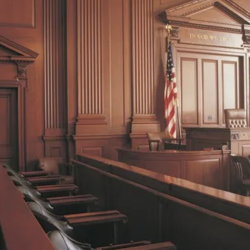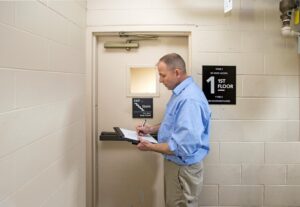Courthouses play a vital role in our justice system, serving as hubs for legal proceedings, administrative tasks, and public services. While the legal aspects of these buildings often take center stage, one critical aspect that should never be overlooked is fire safety. Fire safety is paramount in any public building, and courthouses are no exception. In this comprehensive guide, we will delve into why fire door inspections are crucial in courthouses, exploring the reasons, regulations, and benefits of regular fire door inspections in these institutions.
Fire Safety in Courthouses
The Vulnerability of Courthouses to Fire Incidents
Courthouses are bustling centers of activity with a steady flow of people throughout the day. With numerous rooms, offices, and courtrooms, the potential for fire hazards exists. The combination of large numbers of people, confidential documents, and electronic equipment can create a high-risk environment in the event of a fire.
The Importance of Fire Doors
Fire doors are a fundamental component of fire safety in buildings. They are specially designed to prevent the spread of fire and smoke, allowing occupants to escape safely and firefighters to access the building. In courthouses, where multiple areas may require compartmentalization in case of a fire, the role of fire doors is critical.
The Legal Landscape
Building Codes and Regulations
Courthouses must adhere to strict building codes and regulations to ensure the safety of all occupants. These codes often mandate the installation and maintenance of fire doors. For example, the International Building Code (IBC) and National Fire Protection Association (NFPA) standards provide guidelines for the installation, inspection, and maintenance of fire doors.
Liability and Legal Consequences
Failure to comply with fire safety regulations can result in legal consequences for courthouse authorities. In the event of a fire-related incident, non-compliance may lead to lawsuits, fines, and reputational damage. Regular fire door inspections help courthouses avoid such liabilities.
The Anatomy of Fire Doors
Components of Fire Doors
Understanding the components of fire doors is essential for grasping the importance of inspections. Fire doors consist of various elements, including the door leaf, frame, hardware, and seals. Each component plays a critical role in the door’s ability to resist the spread of fire and smoke.
How Fire Doors Work
Fire doors operate on a simple yet highly effective principle. When a fire is detected, the intumescent seals expand, creating a barrier that prevents smoke and flames from passing through the gaps around the door. The door and its hardware are also designed to withstand high temperatures.
The Need for Regular Inspections
Ensuring Functionality
Over time, fire doors may experience wear and tear that affects their functionality. Regular inspections help identify issues such as damaged seals, misaligned doors, or malfunctioning hardware. Addressing these problems promptly is crucial to maintaining fire door effectiveness.
Compliance with Standards
Building codes and regulations require fire doors to be inspected regularly. Courthouses must demonstrate compliance to ensure the safety of occupants. Inspections should be conducted by certified professionals who understand the specific requirements for fire doors.
Benefits of Fire Door Inspections
Life Safety
The primary purpose of fire doors is to protect lives. Regular inspections ensure that these doors are in optimal working condition, providing a safe means of egress for occupants and allowing firefighters to enter the building to combat the fire.
Property Protection
Courthouses house valuable documents, equipment, and infrastructure. Fire door inspections help safeguard these assets by preventing or limiting fire damage. This not only protects valuable information but also reduces the financial burden of repair or replacement.
The Inspection Process
Frequency of Inspections
Fire door inspections should occur at regular intervals, typically annually, but more frequent inspections may be necessary in high-traffic areas or where there is a higher risk of wear and tear.
Choosing Qualified Inspectors
Selecting qualified inspectors with the appropriate certifications is crucial. They should be well-versed in local building codes and NFPA standards, ensuring that the courthouse remains compliant.
Documentation
Comprehensive records of fire door inspections should be maintained. These records not only demonstrate compliance with regulations but also provide a historical reference for addressing recurring issues or trends.
Addressing Common Fire Door Issues
Faulty Seals
Damaged or improperly sealed fire doors can compromise their ability to contain smoke and flames. Inspectors must check seals for wear, damage, or gaps.
Hardware Malfunctions
Fire door hardware, including latches, hinges, and closers, must function correctly. Inspections identify any hardware issues that may hinder the door’s operation during a fire.
The Cost of Neglect
Hidden Costs
Neglecting fire door inspections may save money in the short term but can lead to higher costs in the long run. Emergency repairs, fines, and potential lawsuits can far outweigh the expenses of regular inspections and maintenance.
Building a Culture of Safety
Training and Awareness
In addition to regular inspections, fostering a culture of safety among courthouse staff and occupants is essential. Training programs and awareness campaigns can help people understand the importance of fire safety and the role of fire doors.
Conclusion
In conclusion, fire safety in courthouses is a matter of utmost importance. A fire door inspection are not just a regulatory requirement but a critical safeguard for the lives of those who work in or visit courthouses. By adhering to building codes, conducting regular inspections, and addressing any issues promptly, courthouses can maintain a safe environment for all stakeholders while avoiding legal liabilities. Investing in fire door inspections is an investment in the safety and integrity of the justice system itself. It is a commitment to upholding the principles of justice while ensuring that the courthouse remains a safe haven for all.




